Instrument Cluster
Warning lights and chimes
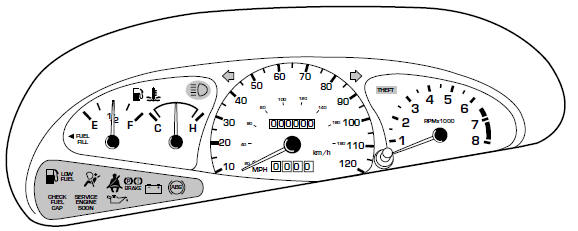
Warning lights and gauges can alert you to a vehicle condition that may become serious enough to cause expensive repairs. A warning light may illuminate when a problem exists with one of your vehicle's functions.
Many lights will illuminate when you start your vehicle to make sure the bulb works. If any light remains on after starting the vehicle, have the respective system inspected immediately.
Service engine soon: If this light
illuminates while driving, it is a
possible indication that one of the
engine's emission control systems
has failed. 
Check fuel cap: Illuminates when
the fuel cap may not be properly
installed. Continued driving with
this light on may cause the Service
engine soon light to come on. 
Brake system warning light: To
confirm the brake system warning
light is functional, it will
momentarily illuminate when the
ignition is turned to the ON position
when the engine is not running, or in a position between ON and START,
or by applying the parking brake when the ignition is turned to the ON
position. If the brake system warning light does not illuminate at this
time, seek service immediately from your dealership. Illumination after
releasing the parking brake indicates low brake fluid level and the brake
system should be inspected immediately by your servicing dealership.

Driving a vehicle with the brake system warning light on is dangerous. A significant decrease in braking performance may occur. It will take you longer to stop the vehicle. Have the vehicle checked by your dealer immediately.
Anti-lock brake system: If the ABS
light stays illuminated or continues to
flash, a malfunction has been
detected, have the system serviced
immediately. Normal braking is still
functional unless the brake warning light also is illuminated.

Air bag readiness: If this light fails
to illuminate when ignition is turned
to ON, continues to flash or remains
on, have the system serviced
immediately. A chime will also
sound when a malfunction in the supplemental restraint system has been
detected. 
Safety belt: Reminds you to fasten
your safety belt. A chime will also
sound to remind you to fasten your
safety belt. 
Charging system: Illuminates when
the battery is not charging properly.

Engine oil pressure: Illuminates
when the oil pressure falls below the
normal range. Refer to Engine oil
in the Maintenance and
Specifications chapter. 
Low fuel: Illuminates when the fuel
level in the fuel tank is at, or near
empty (refer to Fuel gauge in this
chapter). 
Turn signal: Illuminates when the
left or right turn signal or the
hazard lights are turned on. If the
indicators stay on or flash faster, check for a burned out bulb.

High beams: Illuminates when the
high beam headlamps are turned on. 
Key-in-ignition warning chime: Sounds when the key is left in the ignition in the OFF/LOCK or ACC position and the driver's door is opened.
Headlamps on warning chime: Sounds when the headlamps or parking lamps are on, the ignition is off (and the key is not in the ignition) and the driver's door is opened.
Gauges
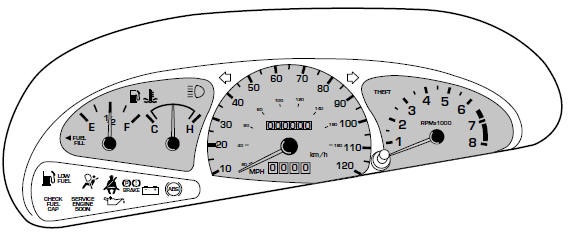
Speedometer: Indicates the current vehicle speed.
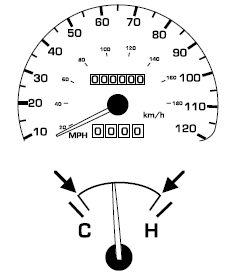
Engine coolant temperature gauge: Indicates engine coolant temperature. At normal operating temperature, the needle will be in the normal range (between "H" and "C").
If it enters the red section, the engine is overheating. Stop the vehicle as soon as safely possible, switch off the engine and let the engine cool.
Never remove the coolant reservoir cap while the engine is running or hot.
Fuel gauge: Indicates
approximately how much fuel is left
in the fuel tank (when the ignition
is in the ON position). 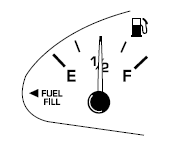
Odometer: Registers the total kilometers (miles) of the vehicle. 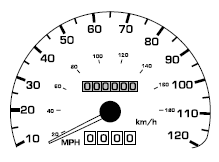
Trip odometer: Registers the kilometers (miles) of individual
journeys. 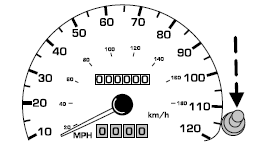
Tachometer: Indicates the engine speed in revolutions per minute.
Driving with your tachometer
pointer continuously at the top of
the scale may damage the engine. 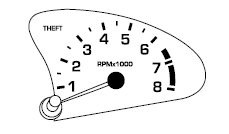
See also:
Oil pump - dismantling, inspection and reassembly
1.8 litre (R2A type)
1 If oil pump wear is suspected, check the
cost and availability of new parts and the cost
of a new pump. Examine the pump as
described in this Section and then decide
whethe ...
Automatic transmission brake band adjustment (Every 24 000 miles (40 000 km)
or 2 years)
Note: A brake band torque wrench - Ford tool
No 17-005, or a conventional torque wrench
and a splined socket of suitable size to fit the
square section head of the adjuster screw(s)
will be requir ...
Air Charge Temperature (ACT) sensor - removal and refitting
Removal
1 The air charge temperature sensor is
screwed into the inlet manifold (see
illustration).
14.1 Air charge temperature sensor - 1.6 EFI engine
A Wiring plug B Sensor
2 Disconnect the b ...
